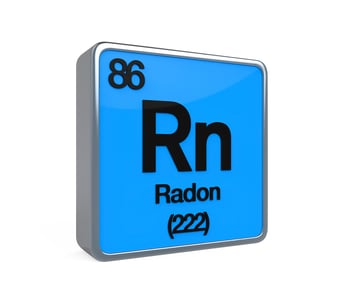How is Radon Linked to Uranium?
You may know that Radon Gas is the second leading cause of lung cancer in the United States, but what you may not know, is how radon is linked to uranium.
- Radon's Link to Uranium
- How Radioactivity is Measured
- Protecting yourself from the Dangers of Radon Gas
- Schedule a Discounted Radon Test
If we want to truly understand Radon Gas, we first need to find out where and how it forms and moves. To do this we need to begin at its ultimate source, uranium.
Radon's Link to Uranium
Radon originates in the natural radioactive decay of uranium from the soil and rocks, such as shale, granite, and phosphate. Radon is present as a gas in the ground, open air, and dissolved water.
Uranium is the first element in a long series of decay that produces both radium and radon.
Uranium is often referred to as the "parent element" and both radium and radon are referred to as the "daughters". Since uranium is present in all rocks and soils, so are radium and radon because they are the "daughter products" that are formed by the radioactive decay of uranium.
Radioactive decay occurs at a specific rate. How fast an element will decay is measured in terms of the its "half-life". Radon has a half-life of 3.8 days, however, the newly made daughter products of radon include polonium, bismuth and lead.
Polonium is also radioactive and it's the element which is produced by radon in the air that can get trapped in people's lungs causing damage and possibly lung cancer to occur.
How Radioactivity is Measured
Radioactivity is normally measured in picocuries (pCi). One pCi is equal to the decay of about two radioactive atoms per minute.
The level of radioactivity is directly related to the number and type of radioactive atoms that are present, which means radon and all other radioactive atoms are measured in picocuries.
If for example a home contains radon levels of 4 picocuries per liter of air (4 pCi/L), it contains roughly 8 or 9 atoms of radon that is decaying every minute in every liter of air inside the home. For a home that is 1,000 square feet with 4 pCi/L of radon, will have nearly 2 million radon atoms that are decaying every minute.
It is recommended by The World Health Organization and The Environmental Protection Agency to have a home mitigated of radon gas if it contains 4.0 pCi/L or higher.

Protecting yourself from the Dangers of Radon Gas
Now that you know radon's link to uranium and the dangers it can cause to our health, it's important to first test your home for radon, and mitigate the problem if there is one.
You need to have your home tested because radon cannot be seen, smelled, or tasted so the only way to know if your home is contaminated is to have it tested by a licensed professional.
It takes two days for the radon testing device to obtain an accurate reading regarding the concentration levels of radon gas inside your home. Once your rest is complete, you will find out the picocuries per liter of radon that is inside your home.
As discussed, it your test comes back with results of 4.0 pCi/L or higher you will need a radon removal system installed to reduce the concentration levels.
The only accurate way to remove radon from your home is to hire a licensed professional to install a mitigation system inside your home. The systems are specifically designed to suck the radon from beneath the home out into the atmosphere.
If you have never had your home tested for Radon Gas, contact the licensed team of testing and mitigation specialists at Radon Eliminator by clicking on the link below.





